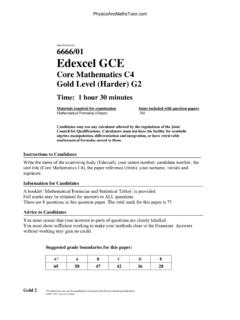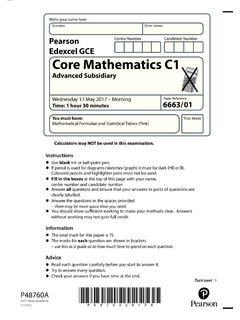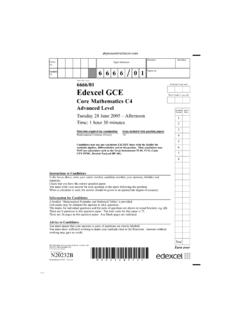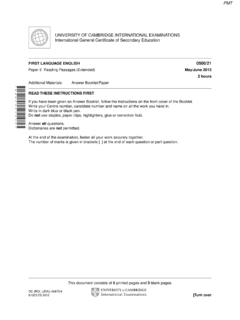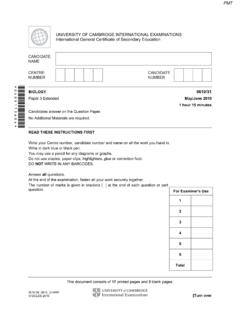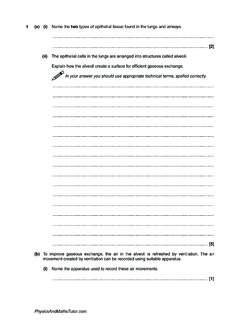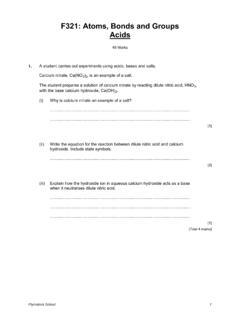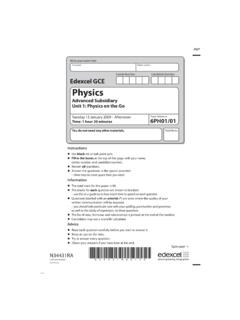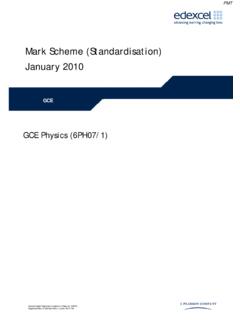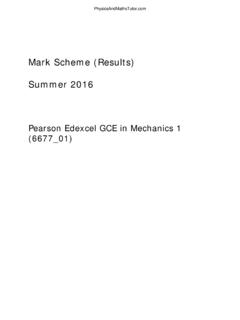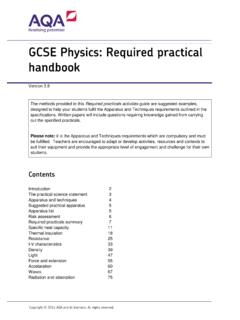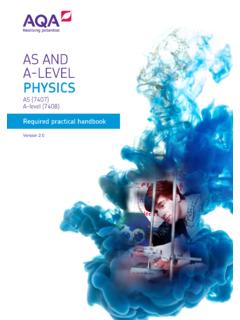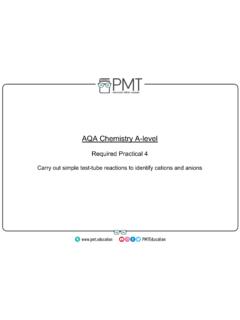Transcription of Required Practical 1 - PMT
1 AQA Chemistry A-level Required Practical 1 Make up a volumetric solution and carry out a simple acid base titration Solution Method Accuracy Explanation 1. Calculate the mass of Required substance needed to produce 250 cm 3 of a mol dm -3 solution. 2. Weigh a clean dry weighing bottle (or weighing boat) on a 2dp balance. 3. Place the weighing bottle on the pan of a digital balance and zero the balance. Using a spatula, place (approximately) the calculated mass of Required substance into the bottle. 4. Remove from the balance, set to zero and re-weigh the weighing bottle and its contents, recording the value. Record all weighings to the resolution of the balance that you have used.
2 5. Pour the contents of the weighing bottle into a clean, glass beaker and re-weigh the weighing bottle, recording the value. Not all of the Required substance will have been transferred. 6. Calculate the mass of Required substance that you have transferred to the beaker [difference in two mass values]. This is weighing by difference . 7. Add approximately 100 cm 3 of deionised (or distilled) water to the beaker containing the solid. Use a glass rod to stir the contents of the beaker until all the solid has dissolved. Sometimes the substance may not dissolve well in cold water so the beaker and its contents could be heated gently until all the solid had dissolved. Use of a rod helps to dissolve the solid.
3 8. Using a funnel, pour the contents of the beaker into a 250 cm 3 volumetric flask. Using further deionised (or distilled) water in a wash bottle, wash out the beaker and funnel, transfering all washings into the volumetric flask. Also rinse the glass rod into these washings. Washings ensue any solution lost in transfer is kept to a minimum. 9. Make the volumetric flask up to the graduated mark by carefully adding deionised water from a wash bottle. Take care not overshoot the graduated mark. Use a dropping pipette for last few drops if necessary. This means the solution has a known volume. 10. Stopper the volumetric flask and invert to combine thoroughly. Helps to mix the contents and ensure uniform solution.
4 Method taken from mark schemes: 1. Weigh the sample bottle containing the solid on a (2 dp) balance. 2. Transfer solid to beaker and reweigh sample bottle. 3. Record the difference in mass. 4. Add distilled water and stir with a glass rod until all the solid has dissolved. 5. Transfer to a volumetric flask with washings. 6. Make up to the 250cm 3 mark with distilled water. 7. Shake flask. Errors: If using anhydrous sodium hydrogensulfate (NaHSO 4 ), make sure it is not too old as it will have picked up water and therefore mass values will not be as accurate. Balance usually gives to (systematic error - same for each value that is recorded). Alternatively the known mass of solid in the weighing bottle could be transferred to beaker, washed and washings added to the beaker.
5 Remember to fill so the bottom of the meniscus sits on the line on the neck of the flask. With dark liquids like potassium manganate (K 2 MnO 4 ) it can be difficult to see the meniscus, so placing a piece of white paper behind to make the marker clearer to see. Reducing uncertainties in measuring mass: Using a more accurate balance or a larger mass will reduce the uncertainty in weighing a solid. Weighing sample before and after addition and then calculating difference (weighing by difference) will ensure a more accurate measurement of the mass added. Method Accuracy Explanation 1. Pour approximately 100cm 3 of the standard solution of known concentration into a beaker.
6 Use a clean, dry beaker. 2. Fill the burette with the standard solution of known concentration. Rinse the burette before using a small volume of the solution. Make sure the jet space in the burette is filled and doesn t contain air bubbles. If the jet space is not filled it will lead to errors if it then fills during the titration, leading to a larger than expected titre reading. 3. Pour approximately 100cm 3 of the solution with unknown concentration into a second beaker. Use a clean, dry beaker. 4. Using a pipette filler and pipette to transfer exactly 25cm 3 of solution into a 250cm 3 conical flask. Rinse the 25cm 3 pipette with the solution of unknown concentration.
7 The conical flask should been rinsed with deionised water. A conical flask is used in preference to a beaker because it is easier to swirl the mixture in a conical flask without spilling the contents. 5. Add two to three drops of phenolphthalein indicator to the solution in the conical flask and note the initial colour of the indicator. Only a few drops of indicator is require. If too much is added it will affect the titration result. 6. Record the initial burette reading. Make sure that all your burette readings are to the appropriate precision and are read from the bottom of the meniscus. 7. Titrate the contents of the conical flask by adding solution to it from the burette until the indicator undergoes a definite, permanent colour change.
8 Record the final burette reading in your table of results. Calculate the titre volume (change in volume in the burette). Add the solution slowly, swirling the flask gently to mix the solution. Add the solution dropwise near the end-point. Distilled water can be used during a titration to wash the sides of the flask so that all reactants are washed into the mixture. This water does not affect the titration as it doesn t change the number of moles of each reactant. Use a white tile underneath the flask to help observe the colour change. 8. Repeat, calculate and record the volume of solution used in the titration in a table (titre volume). Repeat until two concordant results are obtained.
9 Record all of the results that you obtain. You should normally carry out at least three titrations. Conical flask/burette: If solution A is titrated against solution B, it means that solution A is in the conical flask and solution B is in the burette. The alkali usually in conical flask. Results: lf 2 or 3 values are within 3 and are therefore concordant, then the results are accurate and reproducible and the titration technique is good or consistent. Results should be clearly recorded in a table. Result should be recorded in full with both initial and final volume readings. Record titre volumes to 2dp ( cm 3 ). Only make an average titre volume using the concordant titre results.
10 Safety precautions: Acids and alkalis are corrosive (at low concentrations acids are irritants). Wear eye protection and gloves. If spilled immediately wash affected parts after spillage. If a substance is unknown, treat it as potentially toxic and wear gloves. Titrating mixtures: If titrating a mixture to work out the concentration of an active ingredient, it is necessary to consider if the mixture contains other substances that have acid-base properties and could affect the reaction. If they don t have acid-base properties we can titrate with confidence. Testing batches: In quality control it will be necessary to do titrations or testing on several samples as the concentration and amount of the chemical being tested may vary between samples.
